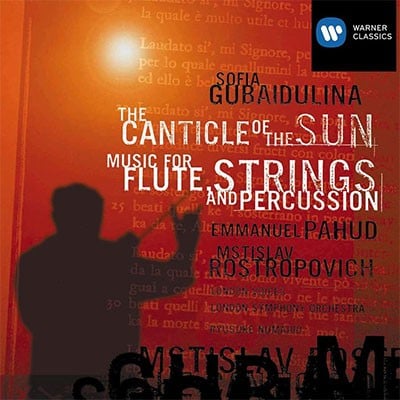The Canticle of the Sun
(Sonnengesang) (1997)Soloist to play:wind.gong/BD/flex
perc(2):timp/glass.chimes/ant.cym/tam-t/bell.plates/marimba;crot/glass.chimes/ant.cym/t.bells/bell.plates/glsp/vib-cel-mixed choir(min.6.6.6.6)
Abbreviations (PDF)
Sikorski
This piece is dedicated to the greatest cellist of the 20th century, Mstislav Rostropovich, on the occasion of his 70th birthday.
And, naturally, it is connected in its nature and character with his personality, which in my imagination is perpetually lit up by the sun, by sunlight, by sunny energy. The singular power and the depth of sound of his cello spurred my imagination towards some kind of very important musical gesture, permitting me to hazard employing for this work the text of the Canticle of the Sun by St. Francis of Assisi.
Of course, this was very audacious of me; but very important in order to reveal the sunny personality of the brilliant musician Mstislav Rostropovich.
I understood that under no circumstances should this text be sung through. Under no circumstances should the expression of this canticle be intensified by music. In coming into contact with these holy texts, under no circumstances should the music be ultra-refined, ostentiously complicated or exaggeratedly captivating. This is the glorification of the Creator and His Creation by a very humble, simple Christian friar.
I tried therefore to make the choral part very restrained; even secretive; and to put all the expression in the hands of the cellist and percussionists. The choral participants very often are the ones who respond to this expression. For that reason, in the centre of the piece is the episode ‘Responsory’: with his gestures (glissandi with his bow on the flexatone) the soloist evokes the response of the chorus.
The form is articulated in four episodes:
- Glorification of the Creator and His Creations – the Sun and the Moon
- Glorification of the Creator, the Maker of the four elements: air, water, fire and earth
- Glorification of life
- Glorification of death
But the overall form is divided into two parts by the episode in which the cellist abandons his instrument: the motive of the overtone row (which is repeated several times in this piece) is played on the C string. Then the cellist retunes this string, gradually reaching the lowest possible pitch; at this pitch he reaches the very brink of his instrument, playing first near the bridge, then on top of the bridge (with a snare drum stick), behind the bridge, on the tailpiece – and finally he abandons his instrument altogether. Now he plays first on the bass drum (legato with a friction stick), and later on a flexatone with a double bass bow, evoking the responses from the choral group with his glissandi. And only after this episode, ‘Responsory’, he returns to his instrument in order to attain its very highest register in the episode ‘Glorification of death’.
Sofia Gubaidulina
"...The Canticle is not so much a concerto-like conversation as a follow-my-leader mystical journey in glorification of the creator, the elements, life and eventually death..."
BBC Music Magazine

Mstislav Rostropovich//London Voices/London Symphony Orchestra/Ryusuke Numajiri
Warner Classics 5571532

